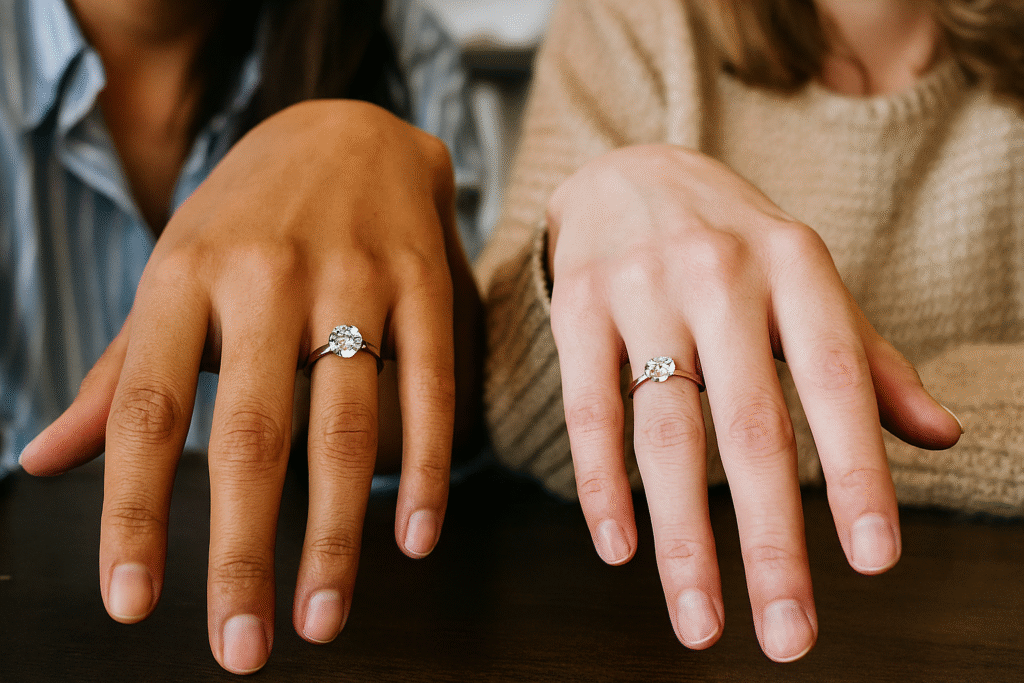Buying a diamond is deeply personal. Yet many buyers fall into what I call “the comparison curse.” The moment a friend shows off their engagement ring, the thought comes: “I want mine to be bigger, clearer, or better.”
The truth is simple: every diamond is unique, just like every buyer’s story. Chasing someone else’s stone often leads to disappointment or overspending. The goal is not to outshine your friend—it’s to find a diamond that matches your taste, budget, and lifestyle.
The Emotional Trap of Comparison
Research shows that 42% of diamond buyers admit comparing their purchase to someone else’s ring. This behavior often drives impulsive decisions and inflated budgets.
As an expert with 40+ years in gemology and the diamond trade, I’ve seen clients regret buying a “status” stone instead of the right one for them.
The key is this: Your diamond should reflect your values, not your neighbor’s.
Case Example
One client came to me after buying a 2-carat diamond just to keep up with her friend. A year later, she traded it for a smaller, better-cut diamond that actually looked brighter and matched her taste.
This is proof that size or “social comparison” is never the full story.
Practical Advice
- Focus on cut and brilliance over size. A well-cut 1.5-carat can outshine a poorly cut 2-carat.
- Set your budget first. Avoid spending just to match someone else’s stone.
- Look for certification. Always buy diamonds with GIA or AGS grading reports.
- Think about wearability. Choose what feels comfortable for daily life, not just for social media photos.
FAQ
Q: Why do people compare their diamonds to others?
A: Because jewelry is emotional and visible. But comparison often leads to overspending.
Q: Can a smaller diamond look better than a larger one?
A: Yes. A well-cut smaller diamond often has more sparkle than a larger but poorly cut one.
Q: What is the smartest factor to prioritize?
A: Cut quality. Research shows cut contributes up to 60% of a diamond’s sparkle.
Q: Should I buy the same diamond shape as my friend?
A: No. Choose a shape that flatters your hand and fits your personal style.
Suggested reading:
How to Budget for an Engagement Ring
Understanding Diamond Quality Factors
Introduction
This Responsible Travel FAQ provides comprehensive answers to help you make ethical tourism choices.
Our guide covers eco-friendly accommodations, local community support, sustainable transportation, cultural respect, wildlife ethics, and ways to reduce waste.
Following these practices ensures your adventures benefit both destinations and travelers.
What is Responsible Travel and Why Does It Matter?
Responsible travel means making conscious choices that minimize negative impact while maximizing benefits for local communities and the environment.
Tourism generates $1.4 trillion annually but produces 8% of global carbon emissions.
Your travel decisions affect local economies, cultural preservation, and environmental conservation.
How Do I Choose Sustainable Accommodations?
Look for eco-certifications such as:
- Green Key
- LEED building standards
- EarthCheck approval
- Rainforest Alliance verification
Check if hotels use renewable energy, water-saving systems, and source food locally.
Ask about waste reduction programs and community involvement. Calling properties directly helps verify claims.
Transportation Options for Responsible Travel
- Train travel emits 80% less carbon than flying for similar distances.
- Choose direct flights when necessary and book economy class.
- Use public transport, bicycles, or walk instead of renting cars.
- Consider verified carbon offsets for unavoidable flights.
Supporting Local Economies
- Buy from locally-owned businesses instead of chains.
- Book community-based tours with local guides.
- Eat at family-owned restaurants with local ingredients.
- Stay in homestays or boutique hotels rather than international chains.
- Purchase authentic handicrafts fairly from artisans.
Packing Tips for Responsible Travel
- Reusable water bottle with filtration
- Solid toiletries to reduce plastic
- Reef-safe mineral sunscreen
- Reusable shopping bags
- Bamboo or metal utensils
- Portable laundry soap
Pack light and choose durable, multipurpose items.
Respecting Local Cultures
- Learn cultural customs, dress codes, and etiquette.
- Learn basic local phrases.
- Dress appropriately for religious and conservative areas.
- Ask permission before photographing people.
- Participate respectfully in cultural activities.
Ethical Wildlife Encounters
- Maintain safe distances and avoid feeding animals.
- Choose conservation-focused sanctuaries, not entertainment attractions.
- Avoid elephant rides, direct contact, or photo opportunities with captive animals.
- Use certified naturalist guides who prioritize welfare and habitat protection.
Reducing Waste During Travel
- Use reusable containers, bags, and utensils.
- Refuse single-use plastics.
- Choose digital tickets and receipts.
- Carry a small trash bag where disposal is limited.
Questions to Ask Tour Operators
- Are staff local and fairly paid?
- How does your business give back to communities?
- What environmental practices are in place?
- Are group sizes limited to reduce pressure on sensitive areas?
- Are wildlife experiences ethical and conservation-focused?
Money and Overtourism Practices
- Use local ATMs and tip according to local customs.
- Support social enterprises and cooperatives.
- Visit during shoulder seasons, off-peak hours, or lesser-known areas.
- Stay longer in fewer destinations.
Responsible Travel on a Budget
- Cook using local market ingredients.
- Use public transportation.
- Stay in local hostels, guesthouses, or homestays.
- Explore free cultural events or walking tours.
- Exchange skills or volunteer for free accommodation.
Pre-Travel Research
- Learn about environmental challenges and cultural sensitivities.
- Check seasonal weather and political situations.
- Identify local organizations to support.
- Read destination-specific responsible travel guides.
Creating a Positive Impact Post-Travel
- Share authentic stories on social media.
- Write detailed reviews for responsible businesses.
- Continue supporting local organizations.
- Apply sustainable practices in daily life.
- Recommend responsible travel to others.
Learn more:



